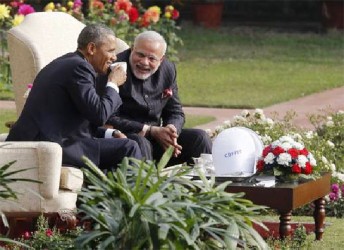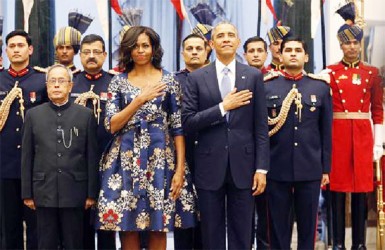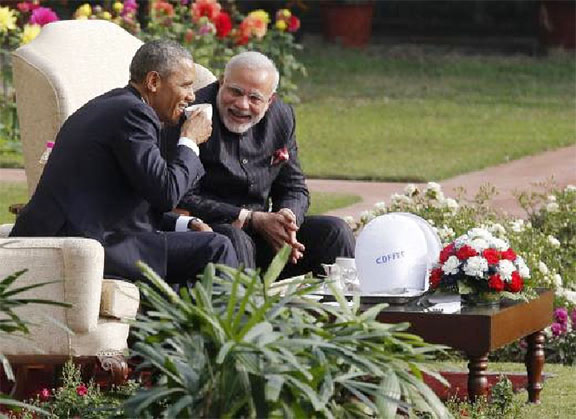NEW DELHI, (Reuters) – In a glow of bonhomie, U.S. President Barack Obama and Indian Prime Minister Narendra Modi unveiled plans to unlock billions of dollars in nuclear trade and to deepen defence ties, steps they hope will establish an enduring strategic partnership.

The two countries reached an understanding on two issues that, despite a groundbreaking 2006 agreement, had stopped U.S. companies from setting up reactors in India and had become one of the major irritants in bilateral relations.
“We are committed to moving towards full implementation,” Obama told a joint news conference with Modi. “This is an important step that shows how we can work together to elevate our relationship.”
The new deal resolved differences over the liability of suppliers to India in the event of a nuclear accident and U.S. demands on tracking the whereabouts of material supplied to the country, U.S. ambassador to India Richard Verma told reporters.
“Ultimately it’s up to the companies to go forward, but the two governments came to an understanding,” he added.
Signalling warmth and determination to take ties to a higher level, Modi broke with protocol to meet and bear-hug Obama as he landed in New Delhi, then referred to him as Barack. It was a remarkable spectacle, given that a year ago Modi was persona non grata in Washington and was denied a visa to the United States.
Between a working lunch that included kebabs made with lotus stem, figs and spices and an evening banquet where Obama spoke a smattering of Hindi, the two leaders got down to talks.

They emerged with a 10-year framework for defence ties and deals on cooperation that included the joint production of drone aircraft and equipment for Lockheed Martin Corp’s C-130 military transport plane.
Other deals ranged from an Obama-Modi hotline — India’s first at a leadership level — to financing initiatives aimed at helping India use renewable energy to lower carbon intensity.
But Modi cautioned that work was still needed to create a solid partnership between the world’s two largest democracies.
“We have to convert a good start into lasting progress. This requires translating our vision into sustained action and concrete achievements,” he said, standing next to Obama.
Today, Obama will be the first U.S. president to attend India’s Republic Day parade, an annual show of military might long associated with the anti-Americanism of the Cold War. He will also host a radio show with Modi.
His presence at the parade at Modi’s personal invitation marks the latest upturn in a roller-coaster bilateral relationship that just a year ago was in tatters.
Up to 40,000 security personnel have been deployed for the visit and 15,000 new closed-circuit surveillance cameras have been installed in the capital, according to media reports.
NEW VITALITY
The United States views India as a vast market and potential counterweight in Asia to a more assertive China, but has frequently been frustrated with the slow pace of New Delhi’s economic reforms and unwillingness to side with Washington in international affairs.
Elected last May, Modi has injected a new vitality into the economy and foreign relations and, to Washington’s delight, has begun pushing back against China across Asia.
In a veiled reference to China, the leaders reiterated the “importance of safeguarding maritime security and ensuring freedom of navigation and overflight throughout the region, especially in the South China Sea”. They also called for the peaceful resolution of territorial conflicts.
Obama will depart slightly early from India to travel to Saudi Arabia following the death of King Abdullah, skipping a planned visit to the Taj Mahal.
Like Obama, Modi rose from modest origins to break into a political elite dominated by powerful families. Aides say the two men bonded in Washington in September when Obama took Modi to the memorial of Martin Luther King, whose rights struggle was inspired by India’s Mahatma Gandhi.
Yesterday, the two leaders talked outside over tea in an elegant garden. Modi, who sold tea on a railway platform as a child, poured a cup for Obama.
The “chemistry” they describe is striking because Modi’s politics is considerably to the right of Obama’s and because he was banned from visiting the United States for nearly a decade after deadly Hindu-Muslim riots in a state he governed.
Obama, the first sitting U.S. president to visit India twice, also enjoyed a close friendship with Modi’s predecessor Manmohan Singh, who staked his premiership on the controversial nuclear deal that made India the sixth “legitimate” atomic power and marked a high point in Indo-U.S. relations.
The deal failed to deliver on a promise of business for U.S. companies because of India’s reluctance to shield suppliers from liability, a deviation from international norms that reflects the memory of the Bhopal industrial disaster.

